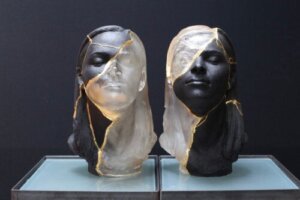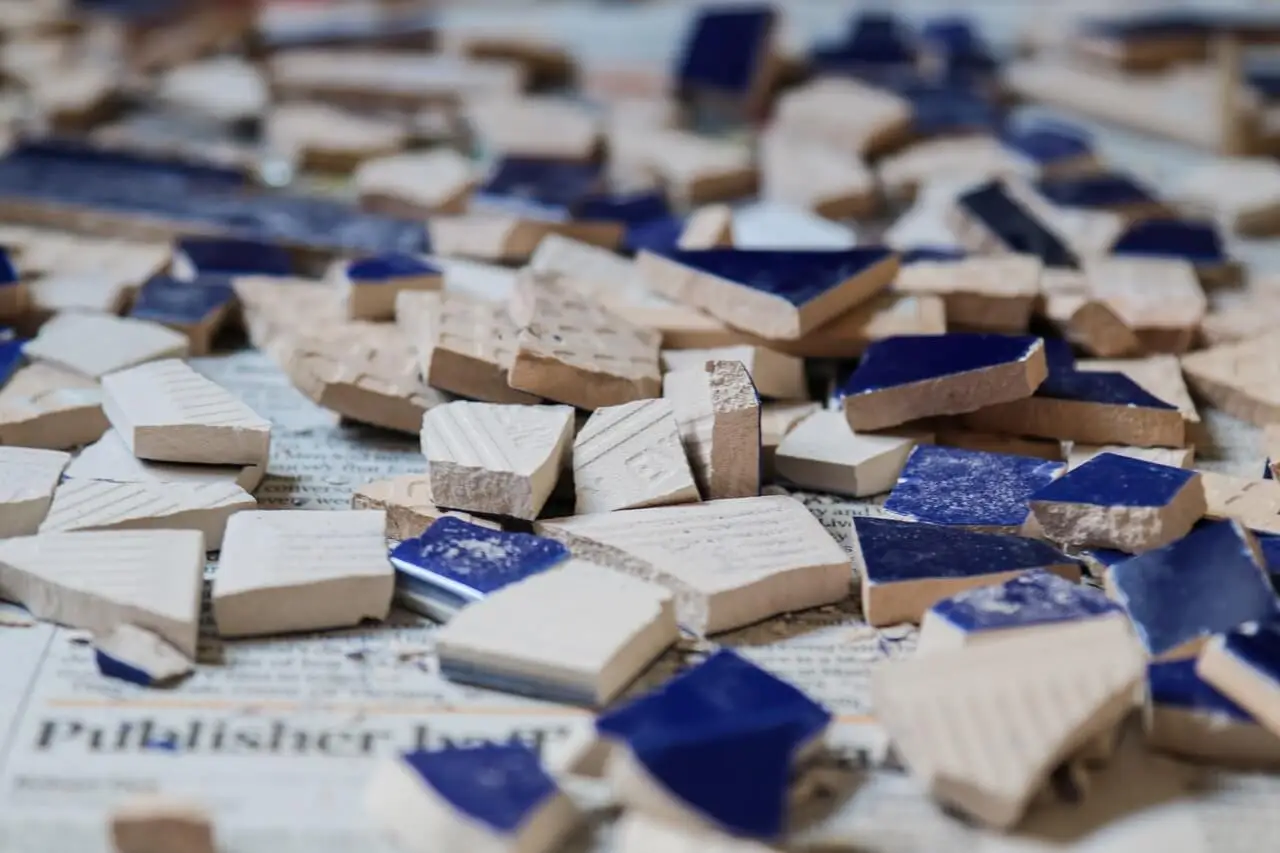Kintsugi: The Philosophy of Mending the Wounds of the Soul

Many people believe that emotional wounds are overcome by burying the pain and acquiring a positive attitude towards life. However, as Kintsugi reflects very well, emotional healing is only possible when we give ourselves the opportunity to accept and feel our inner brokenness, giving space for sadness, anguish, and anger.
Kintsugi is a centuries-old Japanese technique that consists of repairing broken ceramic pieces. However, it also represents a philosophy of life that defends the idea that there’s no point in ignoring wounds or concealing them. On the contrary, it revalues the beauty of the scars, affirming that the breaks are part of the object, making it unique and defining its identity.
What is Kintsugi?
Kintsugi is a Japanese technique that consists of taking the pieces of a broken piece of ceramic and joining its cracks with a varnish sprinkled in gold so that its golden scars stand out to the eye. Although the ceramic piece recovers its original shape, these marks transform its essence into a deeper and more unique version.
However, from a psychological point of view, kintsugi has been used as a metaphor to allude to the confrontation of difficult situations, to its consequent emotional wounds, and to the capacity of human beings to heal the brokenness of the soul.
Under this premise, the key is that we learn to put together the pieces of a broken heart by accepting the pain and wounds that losses and obstacles produce in us. It is these breaks that make us grow as people and become unique, beautiful individuals.
Like this article? We think you may also like to read: High Life Expectancy: Why Do the Japanese Live Longer?
Give space to pain to heal
In the emotional field, grief is the process that’s responsible for healing the wounds produced by the loss of a job, a person, or a project. If we want to overcome it, it’s vital that we make room for sadness, anguish, and anger. That is, we must allow all these emotions to drain, feeling them instead of covering them up.
We have been taught that we must avoid pain at all costs and that the ideal state of every human being is happiness. However, this pretension has done nothing but frustrate the emotional healing in every grieving process.
Instead of facing pain as it should be faced, through acceptance and feeling, however, we often tend to avoid it, repress it, and run away from it as if it were possible to dismiss it out of hand.
Pain is uncomfortable – not only for those who suffer it, but also for those who see it reflected in others. That’s why we often insist on quick solutions, encouraging the affected person to get out of their pitiful state with phrases like: “it’s time to turn the page, let’s have fun, there’s only one life”; or “come on, it’s not that bad, cheer up, everything will be fine”.
In the long run, these interventions are interruptions that prevent us from achieving true healing. This type of healing is only achieved by embracing the pain and emotional wounds.
We think you may also like to read this article: The 5 Stages of Grief and How to Overcome Them

Healing emotional wounds through “Kintsugi”
Céline Santini, in her book Kintsugi, The Art of Resilience, teaches us the path we must follow to heal emotional wounds, according to this Japanese technique.
1. Breaking and holding to the broken parts
This phase corresponds to the experience of adverse events, which break our hearts and soul. Referring to the metaphor of Kintsugi, instead of throwing away the broken piece, the key is to give the object a second chance, joining its parts.
When applied to us, this implies that we accept adverse situations, let ourselves be carried away by the pain, and pick up the shards of the soul to heal it and give it another chance.
To do this, it’s necessary to choose how we are going to repair the situation and visualize how it can be left after this process. Santini emphasizes that when we decide to fix something broken, we’re not only recognizing its value, but also multiplying it.
Choosing to repair ourselves is nothing more than an act of self-love.
2. Reassembly
The next phase is to get down to work, but with patience and without haste. That is to say, just as the material for the kintsugi is gathered carefully and with full awareness, we must slowly and carefully prepare ourselves before embarking on the healing process.
This involves gathering our broken pieces slowly, as if we were about to undertake something sacred: our own transformation. We must be clear about what the parts are and how we are going to assemble them.
According to Santini, this is about doing things differently, taking the time to observe ourselves from the outside, and bringing to consciousness those behaviors that we reproduce unconsciously and that lead us to suffering.
Therefore, when picking up our pieces, it should not be an obsession or other person that helps to fill the void, but we should take the time to find alternatives that calm us down and also make us feel better about ourselves (think: dancing, painting, sports, writing, reading).
We think you may also find this article interesting: The Japanese Method for Eliminating Stress
3. Wait
In kintsugi, the drying stage is key to the recomposition of the object. It’s what guarantees its solidity and durability.
So, for the recomposition of the soul to be effective, we need time. Once the pieces are assembled, it’s also necessary to ensure that they don’t move from their place.
This implies letting things sit so that they become clearer. Letting the psyche work at its own pace while it heals itself. So, at this stage, it’s important to be patient and avoid rushing the healing.
4. Repair
Once the pieces settle, the next step is to polish the result. The irregularities and flaws are still visible, and we must eliminate them. That is, we must focus on how to improve them.
When applied to personal reconstruction, this means learning from past mistakes and modifying those aspects that do not allow us to live fully.
5. The shine phase
In the Kintsugi technique, this stage corresponds to the application of gold dust on the scars of the object. It’s about giving shine to the object to get closer to the final result.
In the process of personal reconstruction, it means giving oneself permission to be joyful again, to shine again. Once we reach this point, we realize how easy it has been to stop enjoying the little things in life and how difficult it has been to get back on our feet.
So, we start to be more careful and protect ourselves more from anything that could bring us down. In addition, we being to show what we have learned and the new people we have become.

6. Contempt the transformation
At this stage, we’ve repaired. What the last process alludes to is enjoying a job well done.
This is about admiring and contemplating our transformation. It’s also about taking the time to truly feel the result, assuming the visible scars with pride, and exposing the creation to the people we care about.
Santini stresses the importance of sharing this experience with others. Everyone has to face adversity at any time in their lives. That’s why it’s helpful to others to show pride in our progress, the beauty of our imperfections, and our journey to healing.
Like this article? We think you may also like to read: Discover the Japanese Method to Save Money
Kintsugi: There’s hope in repair
Santini emphasizes that the metaphor of Kintsugi conveys a message of hope. It’s because it reminds us that we can repair everything. Furthermore, it teaches us that the recomposition ends up being a better version of what the object was before. In that, it appears unique and more beautiful.
So, why not apply this philosophy of life to begin to heal our inner brokenness?
All cited sources were thoroughly reviewed by our team to ensure their quality, reliability, currency, and validity. The bibliography of this article was considered reliable and of academic or scientific accuracy.
- Meza E, García S, Torres A, Castillo L, Sauri S, Martínez B. El proceso del duelo. Un mecanismo humano para el manejo de las pérdidas emocionales. Revista de Especialidades Médico-Quirúrgicas [Internet]. 2008 [consultado el 7 de julio de 2022]; 13(1): 28-31. Disponible en: https://www.redalyc.org/pdf/473/47316103007.pdf
- Santini C. Kintsugi. El arte de la resiliencia. España: Libros Cúpula; 2019.
This text is provided for informational purposes only and does not replace consultation with a professional. If in doubt, consult your specialist.








